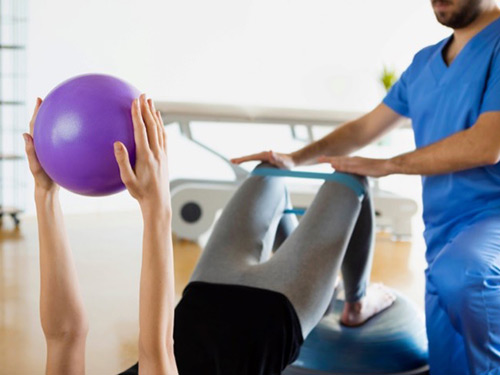Core Strength Is Crucial: How Can Physical Therapist Assistants Help?
 As one of the most essential parts of your body, your core determines everything from your everyday comfort and mobility to your athletic performance. Without sufficient strength, however, you risk poor posture and lower back pain, among a host of other issues. Despite this, many people are minimally aware of their core strength (or lack thereof), nor do they make any effort to develop these crucial muscles.
As one of the most essential parts of your body, your core determines everything from your everyday comfort and mobility to your athletic performance. Without sufficient strength, however, you risk poor posture and lower back pain, among a host of other issues. Despite this, many people are minimally aware of their core strength (or lack thereof), nor do they make any effort to develop these crucial muscles.
Physical therapy aims to combat these issues through education, support and accountability. Below, we explain why core strength is so valuable from the physical therapy assistant’s perspective. We will also highlight the strategies for core strength physical therapy that assistants promote.
Why Is Core Strength an Important Focus of Physical Therapy?
Physical therapy exercises can target every part of the body, but many are only modestly effective when core strength is lacking. After all, a strong core boosts strength-building and mobility-enhancing efforts in all other parts of the body and is also crucial for preventing future injuries. By completing physical therapy core exercises, patients can learn to work their muscles in harmony, ultimately achieving improved stability throughout their entire body.
What Is Considered Your Core?
The term ‘core’ encompasses a variety of muscles but generally refers to the midsection: anything between the diaphragm and pelvic floor that provides stability for the trunk and spine.[1] Specifically, this includes:
- Transverse abdominis
- Rectus abdominis
- Lumbar multifidus
- Erector spinae
What Are the Signs of a Weak Core?
Nearly everyone can benefit from core strengthening, but it is imperative upon observing these critical concerns:
- Poor posture while sitting or standing
- A tendency to lean to one side or even sway while walking
- Bad balance while standing on one leg or navigating slippery or unstable surfaces
- Limited upper body strength, especially when performing pullups or lifting moderately heavy objects
Benefits of Strengthening Your Core
If you have noted one or more of the concerning signs or symptoms highlighted above, it’s time to act. As soon as you gain even modest strength in your core, you will begin to observe the following benefits:
Improved Posture
Excellent posture limits back pain and makes you look and feel more confident. Maintaining posture is difficult when you lack core strength, however. Once the core is strong enough, the muscles involved in proper posture can activate more easily, even when fatigued.
Alleviate Back Pain
As you begin to exhibit better posture, you may be pleased to discover that your lower back pain diminishes dramatically. Interventional pain specialist Dr. Krishna Shaw tells the New York Times[2] that a stronger core functions a lot like a brace, keeping the midsection upright and stable — and while a brace is often the first line of action for alleviating back pain in the short-term, using it excessively can further contribute to the problem, while a stronger core forms “an internal brace, that is more effective.”
Improve Balance and Coordination
Walking on ice walkways will feel a lot less terrifying once your core is in solid shape. While a strong core acts as a brace to limit back pain, it can be more accurately compared to an anchor when balance is involved. Again, these benefits derive from the core’s ability to keep you upright.
Specifically, the core plays into the concept of proprioception, which provides a feedback loop between the nervous system and sensory receptors throughout the body. A stronger core also helps this system work in equilibrium with others, such as the vestibular system in the inner ear.
Increase Athletic Ability
Core strength plays heavily into a variety of athletic activities, including everything from ball sports to dancing, swimming and even hiking. Equipped with a strong core, you could dramatically improve your performance in your sport of choice. Research indicates that, by acting as “hubs in the biological motor chain,” strong core muscles improve transfers of strength through the lower and upper limbs while also boosting general control among athletes.[3] These improvements are especially notable in swimming, dancing, basketball and football.
How Can Physical Therapy Help?
While it is possible to build core strength on your own, this process is safer and far more efficient when you get a physical therapy team in on the action. Physical therapy teams ensure that patients target the right muscles and learn to use them in harmony. They also provide robust accountability and emotional support, as we describe below:
Focused Goals
Core strength takes considerable time and effort to develop and, unfortunately, most people simply don’t have the time nor inclination to fully commit on their own. Without some form of guidance and accountability, even the most well-meaning and ambitious efforts are likely to be abandoned or forgotten.
Physical therapy brings structure to the process, beginning with a purposeful goal-setting initiative. Physical therapy professionals can help patients determine how to build core strength and clarify their reasons for doing so.
Driven and Structured Rehabilitation Plan
After working together to identify meaningful goals, physical therapists and clients can continue their partnership to develop training plans that are easier to follow in the long term. These plans emphasize incremental challenges and improvements, with the goal of not only alleviating short-term pain but also preventing future injuries and boosting long-term performance.
Support of a Physical Therapist Assistant
Physical therapy involves a team mentality, in which the physical therapist is just one of several individuals who will interact with patients.[4] Such a mindset empowers the patient and also draws on numerous perspectives and skill sets to deliver impressive results and a more satisfying experience.
The ideal team will include the physical therapist and a physical therapist assistant (PTA) who works closely with the client to ensure that rehabilitation plans and other regimens are correctly carried out.
In addition to built-in accountability, the PTA provides a constant source of support. They are the ultimate cheerleader: someone who is clearly invested in patients and eager to see them succeed.
How Does a Physical Therapist Assistant Help?
Physical therapist assistants are highly skilled professionals who work closely with patients to implement plans developed by physical therapists. They draw on a wealth of clinical skills and knowledge to provide high-quality support while also offering motivation, accountability and a sense of emotional solace.
Emerging research suggests[5] that PTAs can maintain a high quality of care while also reducing its cost. We’ve identified a few of their essential functions below:
Implementing Treatment Plans
Physical therapists are charged with developing impactful treatment plans tailored to the unique needs of each patient but these plans accomplish little if they are not appropriately carried out. Without PTAs, patients may largely be left to their own devices and may never act on the insight they’ve gained from their physical therapists.
PTAs often handle the implementation side of the equation, working directly with patients to ensure that they complete all the exercises and other interventions designed by physical therapists.[6] While physical therapists determine what patients should do and how, PTAs make sure these steps are actually followed.
Preparing Therapy Equipment During Appointments
Depending on the approved treatment plan, physical therapy sessions may involve the use of props or equipment, including everything from exercise balls to foam rollers. Physical therapist assistants are typically responsible for setting up appropriate tools and equipment. Following each session, PTAs ensure that this equipment is properly stored.[7]
Proper Instruction During Each Session
If rehabilitative exercises aren’t completed properly, clients risk discomfort or even additional injury. To prevent such issues, physical therapist assistants provide detailed instructions and feedback to ensure that every move is carried out correctly.[8] Patients may even find that engaging instruction from PTAs can make prescribed exercises more enjoyable to complete.
What Does It Take to Become a Physical Therapist Assistant?
Are you passionate about helping others improve their health and mobility? You could have a promising future as a physical therapist assistant. First, you will need high-level training that prepares you to work with a variety of clients, addressing not only core strength but also a wide range of common injuries and conditions.
Along the way, you may discover that you, the aspiring professional, benefit from building core exercises and other healthy practices into your life. You could benefit personally and professionally from a comprehensive physical therapist assistant education that encompasses:
Education and Schooling
One of the core requirements for becoming a PTA involves attending and graduating from an accredited education program. Featuring a blend of classroom-based learning, lab experiences and clinical studies, PTA programs provide well-rounded training that exposes aspiring professionals to the daily realities of this profession.[9] You can also emerge equipped with an associate degree, which is a required educational credential for finding work in this profession.
Certification Requirements
Once you have completed your PTA education program, you should be thoroughly prepared to take the National Physical Therapy Examination (NPTE) for PTAs. To work as a physical therapist assistant in California, graduates must also pass the California Law Examination (CAL-Law) which relates to the practice of physical therapy.[10]
Carrington College prepares students to take appropriate certification and licensure exams related to their individual majors. The College does not guarantee students will successfully pass these exams or be certified or licensed as a result of completing the program.
Knowing How to Help Patients
The right degree and education can make a world of difference, but you also need to know how to put your well-rounded knowledge into practice. Look for training opportunities that allow you to apply complex concepts in a real-world setting while also providing the support and encouragement that patients require.
Ready to take the next step as you pursue an exciting and meaningful career? The Physical TherapistAssistant program at Carrington College will provide a strong foundation. Reach out today to learn more about how to prepare for success as a PTA.
Sources:
- Marder, J. “For a Stable, Strong Core, Forget About Crunches.” The New York Times.
- Fairbank, R. “How Simple Exercises May Save Your Lower Back.” The New York Times.
- Luo, S. et al. “Effect of Core Training on Skill Performance Among Athletes: A Systematic Review.” Frontiers.
- Jewell, J. et al. “Transformation of the Physical Therapist Assistant (PTA): A Survey of Current Practice and Education Survey of Current Practice and Education.” Internet Journal of Allied Health Sciences and Practice.
- Biggs, J. “The Impact of Level of Physical Therapist Assistant Involvement on Patient Outcomes Following Stroke.” Physical Therapy.
- Bureau of Labor Statistics. “What Physical Therapist Assistants and Aides Do.”
- O*NET Code Connector. “Physical Therapist Assistants.”
- Bracther, E. “Physical Therapist Assistant Overview.” U.S. News & World Report.
- American Physical Therapy Association. “Becoming a PTA.”
- Physical Therapy Board of California. “US-Educated PT/PTA Applicant — New Graduate.”


